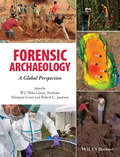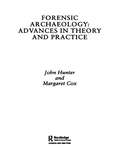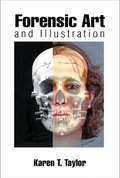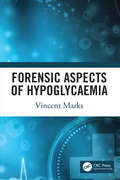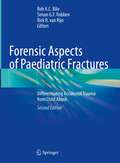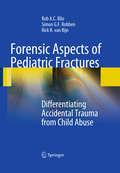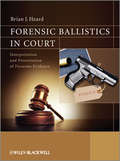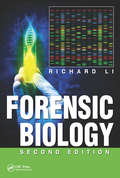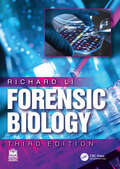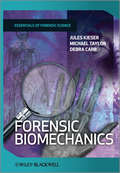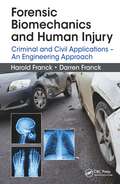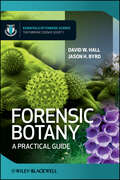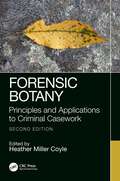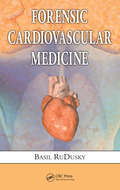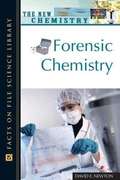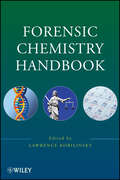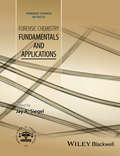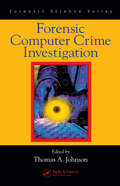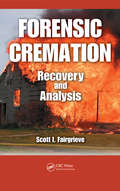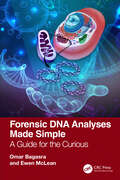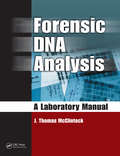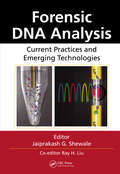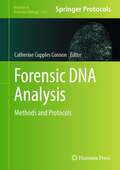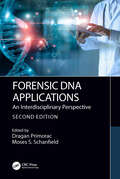- Table View
- List View
Forensic Archaeology: A Global Perspective (Soil Forensics Ser.)
by Nicholas Márquez-Grant W. J. Groen Rob JanawayForensic archaeology is mostly defined as the use of archaeological methods and principles within a legal context. However, such a definition only covers one aspect of forensic archaeology and misses the full potential this discipline has to offer. This volume is unique in that it contains 57 chapters from experienced forensic archaeological practitioners working in different countries, intergovernmental organisations or NGO’s. It shows that the practice of forensic archaeology varies worldwide as a result of diverse historical, educational, legal and judicial backgrounds. The chapters in this volume will be an invaluable reference to (forensic) archaeologists, forensic anthropologists, humanitarian and human rights workers, forensic scientists, police officers, professionals working in criminal justice systems and all other individuals who are interested in the potential forensic archaeology has to offer at scenes of crime or places of incident. This volume promotes the development of forensic archaeology worldwide. In addition, it proposes an interpretative framework that is grounded in archaeological theory and methodology, integrating affiliated behavioural and forensic sciences.
Forensic Archaeology: Advances in Theory and Practice
by John Hunter Margaret CoxThis updated edition of a textbook universally hailed as an indispensable guide, is a complete introduction to the methods and means of forensic archaeology. Incorporating new advances in the field, new case studies, and charting the growth and development of the subject, Forensic Archaeology examines the four main fields of recovery, search, skeletal analysis and analytical science, and how the concepts and methods of traditional archaeology can by utilized within criminal investigations. The authors provide in-depth chapters that discuss: search and location the various constraints and issues posed by an increasingly complex legal environment the archaeology of individual and mass graves how the subject has evolved to include international investigations of human rights links with forensic anthropology forensic geophysical survey. This is an invaluable resource that will provide students, researchers, academics and the general reader alike with a fascinating introduction to this complex and crucial subject.
Forensic Art and Illustration
by Karen T. TaylorAs the number of stranger-on-stranger crimes increases, solving these crimes becomes more challenging. Forensic illustration has become increasingly important as a tool in identifying both perpetrators and victims. Now a leading forensic artist, who has taught this subject at law enforcement academies, schools, and universities internationally, off
Forensic Aspects of Hypoglycaemia: First Edition
by Vincent MarksThe Forensic Aspects of Hypoglycaemia succinctly covers the medicolegal considerations of hypoglycaemia in a variety of scenarios including driving fatalities, petty crime, homicide and suicide. Covering the definitions and diagnosis of hypoglycaemia to its bearing on criminal behavior, this book draws on the author's extensive experience and contains a wealth of information for physicians and lawyers, including cases from the author's past and notable cases in the public domain.
Forensic Aspects of Paediatric Fractures: Differentiating Accidental Trauma from Child Abuse
by Rick R. van Rijn Rob A. C. Bilo Simon G. F. RobbenThis excellently illustrated book, now in a revised and extended second edition, not only describes the radiological findings which can be found in child abuse cases but also places them in a forensic perspective – a crucial aspect often underrepresented in radiological books. The aim is to enable physicians involved in non-accidental trauma cases to interpret radiological findings in light of the forensic circumstances under which these findings have arisen. Accordingly, the book will assist in determining whether a fracture is accidental or the result of abuse. Fractures are addressed not only by anatomical location but also by trauma mechanism, with careful attention to evidence regarding the reported mechanism and the clinical outcome. Drawing on the latest literature, the authors explain whether a particular form of trauma can cause a particular injury and identify where the reader can find the supporting evidence. The book will be essential reading and a superb reference for all who are involved in the diagnosis of child abuse, including pediatricians, emergency room physicians, and radiologists. It will also be a valuable resource for legal medicine physicians, lawyers, and judges.
Forensic Aspects of Pediatric Fractures
by Rick R. van Rijn Rob A. Bilo Simon G. RobbenFractures are a common finding in children and it is estimated that 2.1% of all children will suffer at least one fracture before the age of 16. With young children in particular, the question may arise if this is related to child abuse. The aim of this book is to help physicians involved in child abuse cases to interpret radiological findings in light of the forensic circumstances under which they occurred. The authors present up-to-date literature related to the mechanisms underlying non-accidental cases of trauma. In this book not only the radiological findings in child-abuse are discussed, but more importantly, these findings are analyzed from a forensic perspective. Careful attention is paid to evidence regarding reported trauma mechanisms and their clinical outcome; for example, can a fall from a couch result in a femoral fracture, and if not, where is the supporting evidence?
Forensic Ballistics in Court
by Brian J. HeardForensic Ballistics in Court: Interpretation and Presentation of Firearms Evidence is an accessible introduction to firearms and ballistics evidence and how this is analysed and presented as evidence in a court of law.The book approaches the subject in terms of the realities of case work, opening with a clear and illustrated explanation of the correct nomenclature for various weapon types and their parts. Ammunition is also extensively covered, again with annotated illustrations. Basic external and terminal ballistics, wounding capabilities are likewise covered to give an overview of the subject. A key aspect of the book covers the theory and philosophy behind striation matches and the associated statistics, how positive matches should be peer reviewed and the importance accreditation has on this subject.Gunshot residue formation and identification and the various methods used in its analysis are reviewed in depth. This includes a critical examination of the pros and cons of each type of examination and the evidential weight which can be applied to each method.Accessible and reader-friendly introduction to firearms and ballistics.Clarifies the limitations of firearms evidence.Extensive use of global case-studies throughout.Focus on the interpretation and assessment of the weight of firearms/ballistics evidence presented at court.Covers the importance of witness and accused statements and their interpretation in relation to the investigation under review.Includes coverage of gunshot residue collection, examination and interpretation and the potential for contamination of GSR samples.Includes numerous real life case studies that the author has dealt with over the past 45 years.Takes an applied approach to the subject.
Forensic Biology
by Richard LiFocusing on forensic serology and forensic DNA analysis, this book introduces students to the methods and techniques utilized by forensic biology laboratories. Using schematic illustrations to clarify concepts, this second edition explores the latest DNA profiling tools, contains three new chapters, and provides 200 new images. It also includes new tables for many chapters. Covering the full scope of forensic biology, the book uses an accessible style designed to enhance students education and training so they are prepared, both in the laboratory and in the field.
Forensic Biology
by Richard LiForensic Biology, Third Edition, provides students with a general understanding of forensic biology, particularly in forensic serology and forensic DNA analysis, and addresses rapid advancements in the field over the past few years.The book is divided into 26 chapters that are designed to be covered in a single-semester course for students majoring in forensic science, with the aim of equipping students with the knowledge needed to understand and apply new real-world techniques and methods to prepare them for entry into the field.The third edition: Provides clear explanations of the principles involved in forensic identification and the analysis of biological evidence Explains the techniques used in forensic body fluid identification and DNA profiling, both in the field and in the laboratory Discusses the benefits and limitations of various forensic biology techniques Includes over four hundred color illustrations Includes over three thousand in-text citations This updated and comprehensive volume on forensic biology is suitable for use both in the classroom and as a reference for practicing professionals.
Forensic Biomechanics
by Michael Taylor Jules Kieser Debra CarrBiomechanics is the application of mechanical principles to living organisms, and it is one of the most exciting and fastest growing research areas. In forensic science, it is biomechanics that explains trauma to the body at a crime scene or the fracture of fibers and textiles, and helps interpret blood spatter. Forensic Biomechanics is a comprehensive overview of the role of biomechanics in forensics. Well-illustrated with real-life case studies, and using a multidisciplinary approach, this unique book is an invaluable reference for practicing forensic scientists, lawyers, and researchers.
Forensic Biomechanics and Human Injury: Criminal and Civil Applications - An Engineering Approach
by Harold Franck Darren FranckForensic Biomechanics and Human Injury: Criminal and Civil Applications � An Engineering Approach provides a concise, comprehensive overview of human anatomy and the biomechanical factors involved in human injury. It describes the methodologies used to compute the various forces, stresses, and energies required to injure the human body.The book cov
Forensic Botany
by David W. Hall Jason ByrdForensic Botany: A Practical Guide is an accessible introduction to the way in which botanical evidence is identified, collected and analysed in criminal cases. Increasingly this form of evidence is becoming more important in forensic investigation and yet there are few trained botanists able to assist in such cases. This book is intended to show how useful simple collection methods and standard plant analysis can be in the course of such investigations and is written in a clear and accessible manner to enhance understanding of the subject for the non-specialist.Clearly structured throughout, this book combines well known collection techniques in a field oriented format that can be used for casework. Collection of evidence differs from formal plant collection in that most professional plant collectors are gathering entire plants or significant portions of a plant for permanent storage and reference. Evidence frequently consists of fragments, sometimes exceedingly tiny. Exemplars (examples of reference plants) are collections of plants made in the manner a botanist would collect them. These collections are necessary to link or exclude evidence to or from a scene. Various methods that allow easy collection, transportation, and preservation of evidence are detailed throughout the book.This book is written for those who have no formal background working with plants. It can be used as a practical guide for students taking forensic science courses, law enforcement training, legal courses, and as a template for plant collection at any scene where plants occur and where rules or laws are involved. Veterinarians, various environmental agencies, anthropologists, and archeologists are examples of disciplines that are more recently in need of plant evidence. Veterinarians are becoming more active in pursuing cases of animals that have been abused or are victims of illegal killing. Anthropologists and archeologists are often called to help with body recovery in outdoor environments. Environmental agencies are increasingly forced to adopt rules for resource protection, are in need of a guide for procedures for plant evidence collection and application.The format of the book is designed to present the reader with all the information needed to conduct a botanical analysis of a crime scene; to highlight the forensic significance of the botanical evidence that may be present; how to collect that evidence in the correct manner and preserve and store that evidence appropriately- also shows how to conduct a laboratory analysis of the plants.
Forensic Botany: Principles and Applications to Criminal Casework
by Heather Miller CoyleIncreasingly, forensic scientists use plant evidence to reconstruct crimes. The forensic aspects of this subject require an understanding of what is necessary for botanical evidence to be accepted in our judicial system.Bringing together the latest information into a single resource, Forensic Botany: Principles and Applications to Criminal
Forensic Botany: Principles and Applications to Criminal Casework
by Heather Miller CoyleForensic Botany: Principles and Applications to Criminal Casework, Second Edition updates what, at the time, was the very first book published on the subject. This latest edition offers a concise introduction to plant identification, biology, genetics, and how to utilize and apply botanical evidence in criminal cases.In recent years, forensic botany and the use of various plant and plant‑derived evidence have been increasingly utilized in criminal investigations and court cases. Likewise, forensic palynology and other such terms have entered the vernacular as botanical sciences have widened the applications in which such evidence can help solve cases. This includes the use of current and emergent genetic markers and DNA technology, toxicology, diatoms, and pollen. The numerous advances since the last edition was published necessitated added coverage of the technology and testing capabilities that have achieved new levels as the field has developed.The chapters are written by some of the top experts in the field. Every chapter in the Second Edition is fully updated, with several new chapters focusing on Random Amplified Polymorphic DNA (RAPD), Restriction Fragment Length Polymorphism (RFLP), and Amplified Fragment Length Polymorphism (AFLP), plant‑derived toxins and forensic toxicology, identifying ancient plants used in burial practices for dating sites, digested plants as evidence, and more.Forensic Botany, Second Edition provides scientists working with DNA, trace evidence, and botanical evidence—as well as investigators and legal professionals—with a thorough understanding of the latest advances and current capabilities in utilizing such evidence in investigating and adjudicating criminal cases.
Forensic Cardiovascular Medicine
by Basil RuDuskyAdvance Praise for Forensic Cardiovascular Medicine"Using his vast experience in the medical-legal theater, Dr. RuDusky addresses a very complicated field in a simple and concise manner. Stressing the importance of honesty, integrity, and accuracy of data, he provides an insightful and interesting approach to the problems facing today's medical com
Forensic Chemistry
by David E. NewtonForensic Chemistry examines the most important recent developments in this field and their contribution to crime investigation. The book explores the expanding array of instruments, on-site equipment, chemicals, and other means with which evidence is examined, as well as state-of-the-art forensic procedures.
Forensic Chemistry Handbook
by Lawrence KobilinskyA concise, robust introduction to the various topics covered by the discipline of forensic chemistryThe Forensic Chemistry Handbook focuses on topics in each of the major chemistry-related areas of forensic science. With chapter authors that span the forensic chemistry field, this book exposes readers to the state of the art on subjects such as serology (including blood, semen, and saliva), DNA/molecular biology, explosives and ballistics, toxicology, pharmacology, instrumental analysis, arson investigation, and various other types of chemical residue analysis. In addition, the Forensic Chemistry Handbook:Covers forensic chemistry in a clear, concise, and authoritative wayBrings together in one volume the key topics in forensics where chemistry plays an important role, such as blood analysis, drug analysis, urine analysis, and DNA analysisExplains how to use analytical instruments to analyze crime scene evidenceContains numerous charts, illustrations, graphs, and tables to give quick access to pertinent informationMedia focus on high-profile trials like those of Scott Peterson or Kobe Bryant have peaked a growing interest in the fascinating subject of forensic chemistry. For those readers who want to understand the mechanisms of reactions used in laboratories to piece together crime scenes--and to fully grasp the chemistry behind it--this book is a must-have.
Forensic Chemistry: Fundamentals and Applications (Forensic Science in Focus)
by Jay SiegelForensic Chemistry: Fundamentals and Applications presents a new approach to the study of applications of chemistry to forensic science. It is edited by one of the leading forensic scientists with each chapter written by international experts specializing in their respective fields, and presents the applications of chemistry, especially analytical chemistry, to various topics that make up the forensic scientists toolkit. This comprehensive, textbook includes in-depth coverage of the major topics in forensic chemistry including: illicit drugs, fibers, fire and explosive residues, soils, glass and paints, the chemistry of fingerprint recovery on porous surfaces, the chemistry of firearms analysis, as well as two chapters on the key tools of forensic science, microscopy and chemometrics. Each topic is explored at an advanced college level, with an emphasis, throughout the text, on the use of chemical tools in evidence analysis. Forensic Chemistry: Fundamentals and Applications is essential reading for advanced students of forensic science and analytical chemistry, as well as forensic science practitioners, researchers and faculty, and anyone who wants to learn about the fascinating subject of forensic chemistry in some depth. This book is published as part of the AAFS series 'Forensic Science in Focus'.
Forensic Computer Crime Investigation (International Forensic Science and Investigation)
by Thomas A. JohnsonThe Digital Age offers many far-reaching opportunities - opportunities that allow for fast global communications, efficient business transactions and stealthily executed cyber crimes. Featuring contributions from digital forensic experts, the editor of Forensic Computer Crime Investigation presents a vital resource that outlines the latest strategi
Forensic Cremation Recovery and Analysis
by Scott I. FairgrieveThis book provides a synopsis of the challenges involved in the recovery and interpretation of cremains from the point of discovery to the end of the analysis. It considers the capacity and mechanism of fire to alter the chemical and physical properties of materials, particularly those of human tissues, and emphasizes a flexible approach to the collection of cremains. A significant portion of the book examines the effects of fire on bone and the ability to determine trauma. It also evaluates the practical use of dental tissue and DNA for identification and as an aid to the investigation.
Forensic DNA Analyses Made Simple: A Guide for the Curious
by Omar Bagasra Ewen McLeanSequencing genetic material is now common practice. The general population have become consumers of this information but without an understanding of the biological processes that render sequencing data useful. The interpretation of genetic sequence depends on an appreciation of the basics of genetics and the limits of such data. This book provides the background necessary to understand, interpret, and apply sequencing information to real- world problems. Replication of genetic material, the structure of DNA, typing methods, and forensic applications are all discussed in this useful primer. Key Features • Provides self-learning about DNA fingerprinting. • Includes sections on how to analyze and interpret DNA fingerprinting. • Covers legal and medicolegal issues and case analyses. • Teaches novice legal community about DNA fingerprints. • Summarizes for a general audience the role of ancestry, DNA, and what that means.
Forensic DNA Analysis: A Laboratory Manual
by J. Thomas McClintockIn its short but active history, the use of DNA typing has revolutionized criminal investigations. It is almost inconceivable to bring a case to trial without positive identification through what is now our most accurate means. Proficiency with the methodology, principles, and interpretation of DNA evidence is crucial for today‘s criminalist.
Forensic DNA Analysis: Current Practices and Emerging Technologies
by Jaiprakash G. ShewaleThe field of forensic DNA analysis has grown immensely in the past two decades and genotyping of biological samples is now routinely performed in human identification (HID) laboratories. Application areas include paternity testing, forensic casework, family lineage studies, identification of human remains, and DNA databasing. Forensic DNA Analysis:
Forensic DNA Analysis: Methods and Protocols (Methods in Molecular Biology #2685)
by Catherine Cupples ConnonThis volume focuses on the latest techniques used in forensic DNA analysis. The chapters include a comprehensive collection of extraction, quantification, STR amplification, and detection methods for routine forensic samples, including manual, semi-automated, and automated procedures using both home-brew and commercial products. The chapters also discuss probabilistic modeling software and specialized start-to-finish procedures for mitochondrial DNA analysis, archived latent fingerprints, latent DNA, rapid DNA profiling, and next-generation sequencing. Written in the highly successful Methods in Molecular Biology series format, chapters include introduction to their respective topics, lists of the necessary materials and reagents, step-by-step, readily reproducible laboratory protocols, and tips on troubleshooting and avoiding known pitfalls.Cutting-edge and practical, Forensic DNA Analysis: Methods and Protocols is a valuable resource for researchers interested in learning more about forensic DNA analysis procedures.
Forensic DNA Applications: An Interdisciplinary Perspective
by Dragan Primorac and Moses S. SchanfieldForensic DNA Applications: An Interdisciplinary Perspective, Second Edition is fully updated to outline the latest advances in forensic DNA testing techniques and applications. It continues to fill the need for a reference book for people working in the field of forensic molecular biology testing and research as well as individuals investigating and adjudicating cases involving DNA evidence, whether they be civil or criminal cases. DNA techniques have greatly impacted obvious traditional forensic areas, but such advances have also positively affected myriad new areas of research and inquiry. It is possible today to think about solving forensic problems that were simply unheard of even a few years ago. As such, the book pulls all relevant research and applied science together into a detailed and comprehensive collection. Part I begins with the history and development of DNA typing and profiling for criminal and civil purposes. It discusses the statistical interpretation of results with case examples, mitochondrial DNA testing, Y single nucleotide polymorphisms (SNPs) and short tandem repeats (STRs), and X SNP and STR testing. It also explores low copy number DNA typing, mixtures, and quality assurance and control. Part II moves on to cover the various uses and applications of analyzing collected physical evidence, victim identification in mass disasters, analyzing animal DNA, forensic botany, and other unique applications. Part III is dedicated to the latest advances and developments in human molecular biology and Part IV looks at policies and laws and ethics governing DNA evidence, and its utilization in various cases and the courts. Forensic DNA Applications, Second Edition covers cutting-edge research and advancements in the field and is the most up-to-date reference available. Edited and contributed to by the world's foremost leaders in the field, it is a must-have reference for established professionals, and an essential resource to legal professionals—lawyers and judges dealing with civil and criminal cases involving DNA technology—as well as students entering the fields of genetics and forensic DNA analysis.
